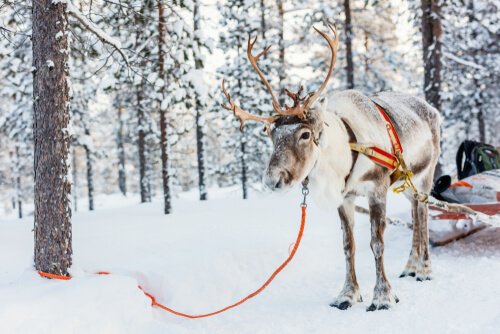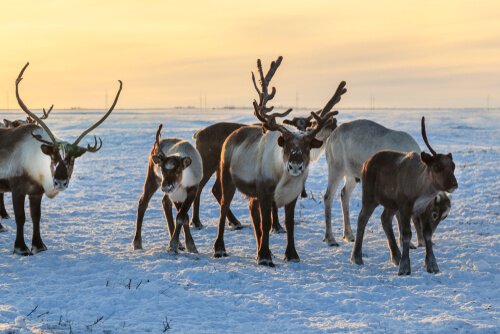7 curious facts about reindeer
Reindeer is a very prominent animal in our music and Christmas images . The reindeer pull Santa's sleigh, have red noses, have curious names and fly. But how much do we really know about this species of northern deer?
These animals are made for the cold . Your nose heats the air before it reaches your lungs, and your entire body, including your hooves, are covered in skin. In the winter, this species must dig through the snow to find food. They dig using their antlers and eat energy lichens, better known as reindeer mosses.
Here we have 6 curious facts about reindeer
1. Antlers for both sexes
Reindeer are the only species of deer in which males and females possess a pair of horns , and a new set is born every year. The antlers of the male can measure up to 51 inches long and weigh up to 14 kilometers. In females they can grow up to 20 inches.
The size of the reindeer varies considerably depending on the subspecies . Finland's forest reindeer are almost 2.5 meters long, nose to tail. These animals have longer legs and wider hooves, and the antlers grow closer together.
2. A reindeer with any other name is still a reindeer
Depending on their location they can receive several names . They are called reindeer in Europe, but in North America, reindeer refers to Eurasian populations, while caribou refers to wild populations in North America.
In other regions, with often they refer to reindeer as domesticated specimens, while caribou refers to the wild population . The reindeer belong to the family Cervidae , which includes deer, elk and wapiti among others. All members of the Cervidae family have horns, hooves and long legs.
3. They are made for the cold
Definitely this species is made to withstand the inclemency of winter weather. Can be found in Alaska, Canada, Greenland, northern Europe and northern Europe. Asia in tundra habitats, mountains and inhospitable forests.

The reindeer is uniquely equipped to live in extreme climates. Your nose works like a small heater, and that is that it heats the air you breathe . It also condenses the water in the air to conserve the moisture of the mucous membranes.
Its fur works like a fur coat that not only traps the air to keep its body isolated, It also acts as a flotation device when it enters the water. They are strong and fast swimmers. When they migrate, they travel through difficult terrain and swim through large rivers and even the icy water of the Arctic Ocean.
Their pads adapt according to the seasons : in winter, your pads contract and retract; they become something like an ice pick used to cut the surface of ice and snow to dig and find food. In summer, when the soil is soft and humid, the pads of your feet expand again, which gives the reindeer better traction.
4. He does not like to live alone
Reindeer are very social creatures . They feed, travel and rest in groups called herds. These herds can include from 10 animals to a few hundred. In the spring, the herds can increase even more: from 50,000 to 500,000 members.
5. The baby reindeer skips the stage of child
The reindeer males are called bulls, the females are called cows and the babies are called calves, just as in cattle.They begin their first game of antlers around their second birthday, reach maturity from 4 to 6 years of age, and their average life is from 15 to 18 years.

6. They are strict vegetarians
Reindeer are herbivores, which means they only eat plants , including ferns, sprouts, herbs, mosses, fungi and leaves. An adult reindeer can eat four to eight kilos of vegetation per day. Reindeer have a keen sense of smell, which is useful when the ground is covered in snow.
They can smell lichens full of energy and useful for heating the blood, called reindeer mosses, even when they are buried less than 60 centimeters from the white matter.
7 Reindeer run like the wind
Reindeer, generally, cover 20 to 60 kilometers day during the migration and run at speeds of up to 80 km/h . Even one-day calves can outperform an Olympic runner. Not all reindeer migrate, but some travel longer distances than any other migratory land mammal.
Certain reindeer populations in North America travel more than 4 800 kilometers per year . Reindeer are strong swimmers and can reach 6-9 km/h in water. Migratory herds swim through large lakes and wide rivers.
Detail by detail, reindeer are pretty impressive creatures . They are also threatened by global warming, oil exploration and other pressures caused by man. Surely they will need help and appreciation from the next generations.


